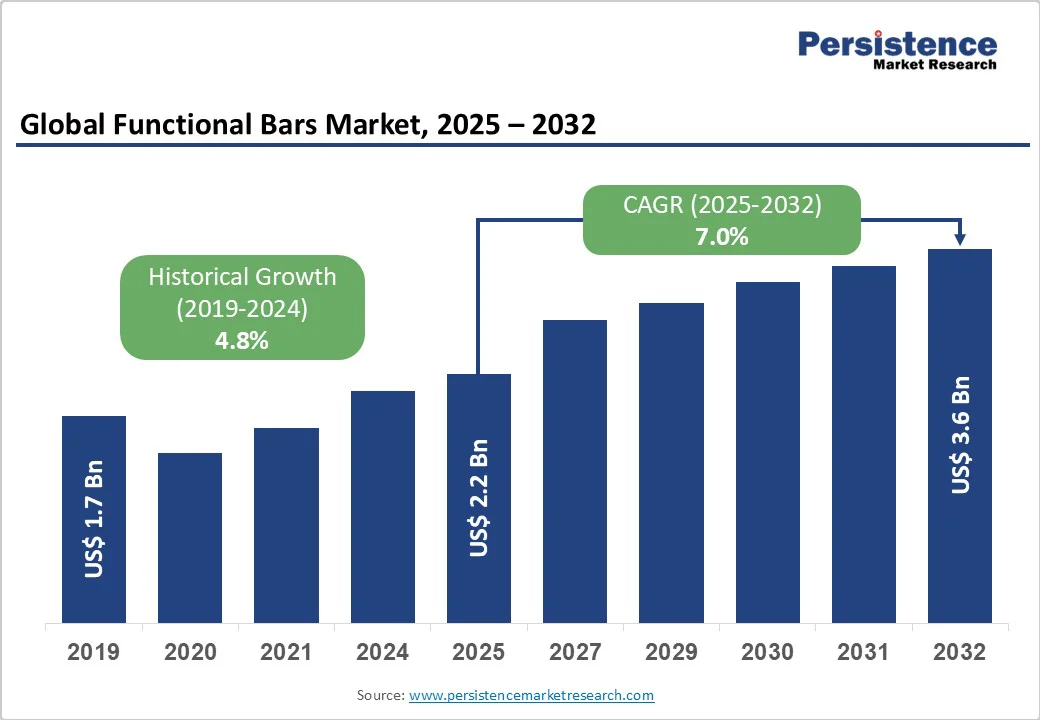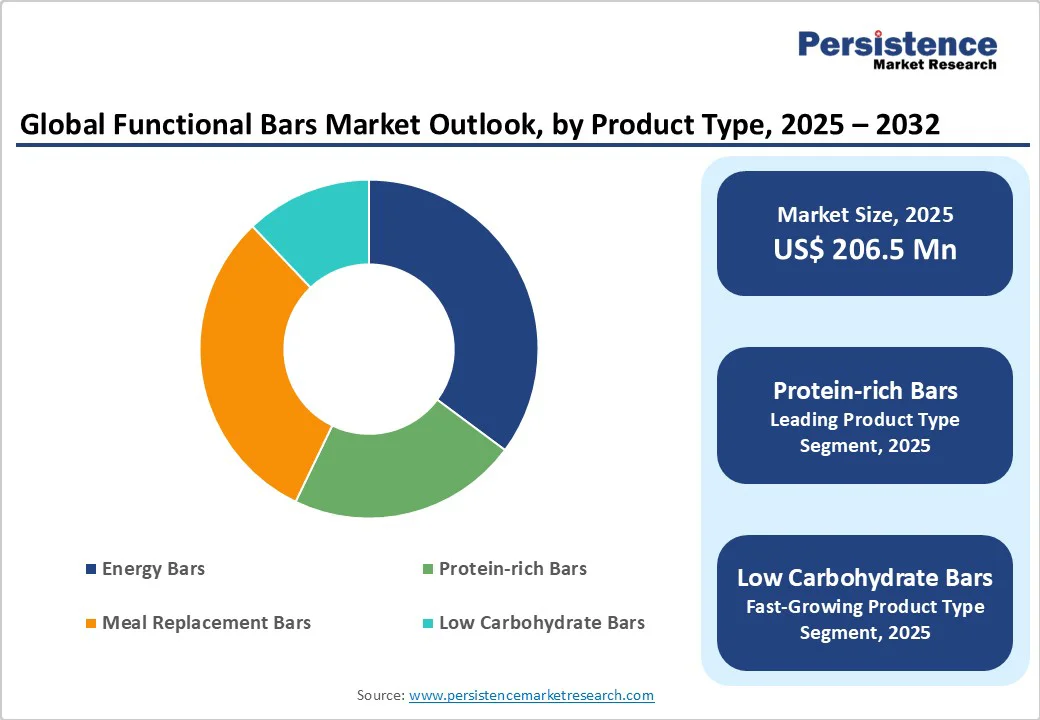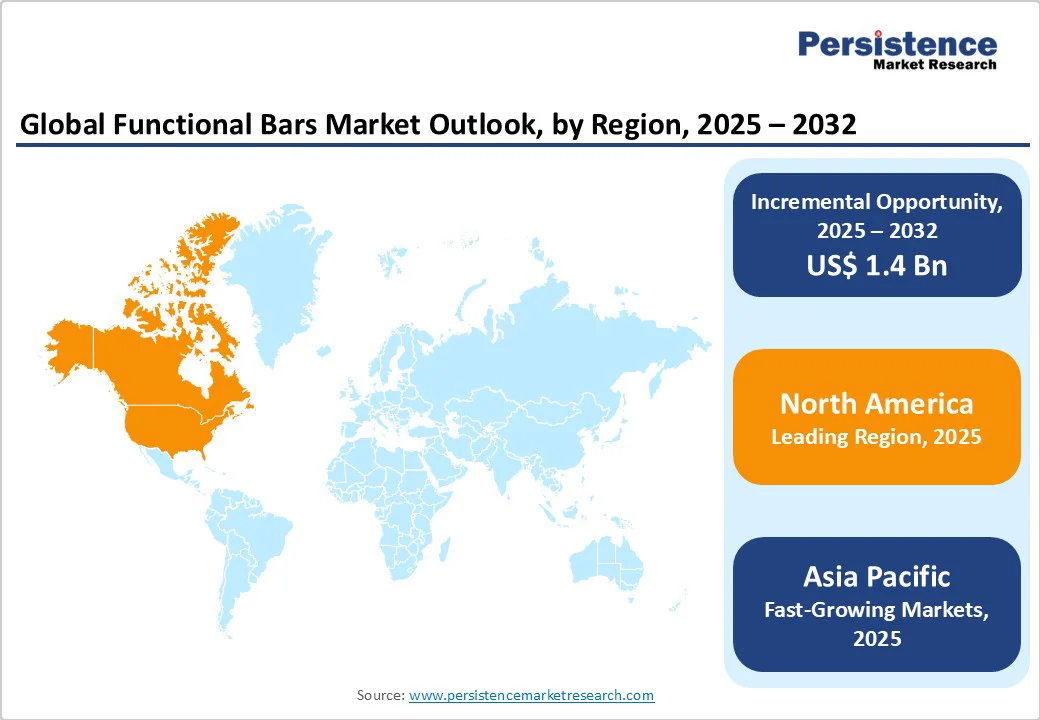ID: PMRREP22771| 196 Pages | 29 Oct 2025 | Format: PDF, Excel, PPT* | Food and Beverages

The global functional bars market size is likely to value US$2.2 billion in 2025 and is projected to reach US$3.6 billion by 2032, growing at a CAGR of 7.0% during the forecast period from 2025 to 2032. Increasing health consciousness and the rising demand for convenient, nutritious snacks has encouraged the demand for functional bars. Consumers are seeking products that offer targeted benefits such as protein supplementation, energy boosting, weight management, and overall wellness. Trends like clean-label ingredients, plant-based formulations, and sustainable packaging are shaping product development, while customization and personalization cater to diverse lifestyles.
| Key Insights | Details |
|---|---|
|
Functional Bars Market Size (2025E) |
US$2.2 Bn |
|
Market Value Forecast (2032F) |
US$3.6 Bn |
|
Projected Growth (CAGR 2025 to 2032) |
7.0% |
|
Historical Market Growth (CAGR 2019 to 2024) |
4.8% |

Rising health consciousness among Millennials and Gen Z is emerging as a major driver for the functional bars market. These younger consumers are not only focused on calorie intake but also on the overall nutritional profile and functional benefits of what they consume. They actively seek snacks that provide energy, protein, or immunity support while aligning with lifestyle preferences such as plant-based, low-sugar, or clean-label ingredients. Social media influence, fitness trends, and increased awareness of chronic diseases have heightened their focus on preventive nutrition. This cohort prioritizes convenience without compromising health, making functional bars an ideal solution. As a result, brands are innovating with flavors, textures, and nutrient profiles to cater specifically to this well-informed, health-driven demographic, boosting market adoption globally.
High pricing for premium ingredients is one of the significant restraints in the functional bars market. Manufacturers increasingly rely on specialty proteins such as whey isolates, pea protein, or collagen, along with plant-based sources like quinoa, chia, and hemp, to meet the growing consumer demand for high-quality, nutritious, and clean-label products. While these ingredients enhance the functional and health benefits of the bars, they substantially increase raw material costs and overall production expenses. Consequently, the final retail price of such bars tends to be higher than conventional snacks, limiting accessibility for price-sensitive consumers, particularly in emerging markets. This price barrier can restrict market penetration, reduce repeat purchases, and force companies to carefully balance quality, functionality, and affordability to sustain growth.
The demand for plant-based and vegan functional bars is rapidly increasing as consumers shift toward sustainable, ethical, and health-conscious lifestyles. These bars are formulated using plant-derived proteins such as pea, soy, nuts, seeds, and legumes, offering a nutritious alternative to traditional animal-based protein bars. They appeal not only to vegans but also to flexitarians and environmentally conscious individuals seeking to reduce their carbon footprint. Beyond protein, many of these bars are enriched with fiber, vitamins, and minerals, supporting overall wellness. The segment’s growth is further fueled by rising awareness of animal welfare, clean-label preferences, and the global trend toward sustainable nutrition.
Protein-rich bars dominate the functional bars market due to the growing emphasis on fitness, muscle recovery, and active lifestyles worldwide. Consumers, including athletes, gym enthusiasts, and health-conscious individuals, prefer these bars as a convenient and portable source of high-quality protein, supporting muscle building and post-workout replenishment. Unlike traditional snacks, protein-rich bars provide targeted nutritional benefits, making them more functional and purpose-driven. Rising awareness about protein’s role in weight management, satiety, and metabolic health has further strengthened its appeal. Additionally, innovations in taste, texture, and clean-label ingredients have broadened their consumer base, attracting not only sports-oriented individuals but also everyday users seeking a nutritious, on-the-go snack, solidifying their position as the leading segment.
Supermarkets and hypermarkets dominate the functional bars market because they offer maximum visibility and accessibility to a broad consumer base. Shoppers often purchase functional bars alongside their routine grocery items, making these channels the most convenient and habitual point of sale. Retailers can display a wide variety of brands, flavors, and premium options, allowing consumers to compare and choose easily. Additionally, strategic product placement, promotions, and in-store sampling enhance consumer engagement and drive impulse purchases. While online stores are growing rapidly, supermarkets’ established infrastructure, high footfall, and trusted shopping experience ensure they continue to hold the largest market share globally.

North America, particularly the U.S., leads the functional bars market due to high health awareness, active lifestyles, and fitness culture. Consumers increasingly prefer protein-rich, low-sugar, and plant-based bars to support muscle recovery, weight management, and wellness goals. The market is driven by gym-goers, athletes, and busy professionals seeking convenient on-the-go nutrition. Innovation in flavors, clean-label ingredients, and fortified formulations with vitamins, minerals, and adaptogens is widespread. Retail penetration through supermarkets, hypermarkets, and online channels further strengthens reach. Additionally, sustainability initiatives and eco-friendly packaging resonate with North American consumers, reinforcing the region’s position as the largest and most innovative functional bars market globally.
The Asia Pacific functional bars market is emerging rapidly, driven by urbanization, rising disposable incomes, and growing health awareness across countries like China, India, Japan, and Australia. Consumers are increasingly adopting convenient, nutritious snacks to complement busy lifestyles, fitness routines, and wellness goals. There is a notable preference for protein-rich, energy, and plant-based bars, with innovation focused on local flavors, functional ingredients, and clean-label formulations. E-commerce and modern retail channels are expanding, making products more accessible in both urban and semi-urban areas. Additionally, rising awareness of obesity, diabetes, and lifestyle-related health issues fuels demand. Sustainability trends, eco-friendly packaging, and region-specific marketing strategies are positioning Asia Pacific as the fastest-growing and dynamic functional bars market.

The functional bars market is highly competitive, driven by continuous innovation and evolving consumer preferences. Key players focus on product diversification, introducing bars with protein enrichment, energy-boosting properties, and wellness benefits. Brands are leveraging strategic partnerships, new distribution channels, and direct-to-consumer approaches to expand their market presence. Innovation in flavors, plant-based ingredients, and sustainable, eco-friendly packaging has become a critical differentiator.
The global functional bars market is likely to value at US$2.2 Bn in 2025.
Consumers are increasingly conscious of nutrition, wellness, and balanced diets, boosting demand for functional snacks.
The global functional bars market is poised to witness a CAGR of 7.0% between 2025 and 2032.
Custom formulations based on fitness goals, lifestyle, or health needs.
Prinsen Food Group B.V., Frankonia Schokoladenwerke GmbH, Bedouin S.A.S, Nutrition & Santé SAS, and others.
| Report Attribute | Details |
|---|---|
|
Historical Data/Actuals |
2019 - 2024 |
|
Forecast Period |
2025 - 2032 |
|
Market Analysis |
Value: US$ Mn, Volume if Applicable |
|
Geographical Coverage |
|
|
Segmental Coverage |
|
|
Competitive Analysis |
|
|
Report Highlights |
|
By Product Type
By Format
By Distribution Channel
By Region
Delivery Timelines
For more information on this report and its delivery timelines please get in touch with our sales team.
About Author